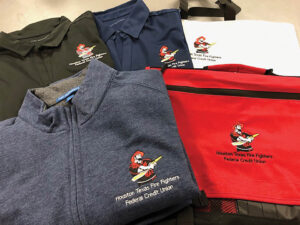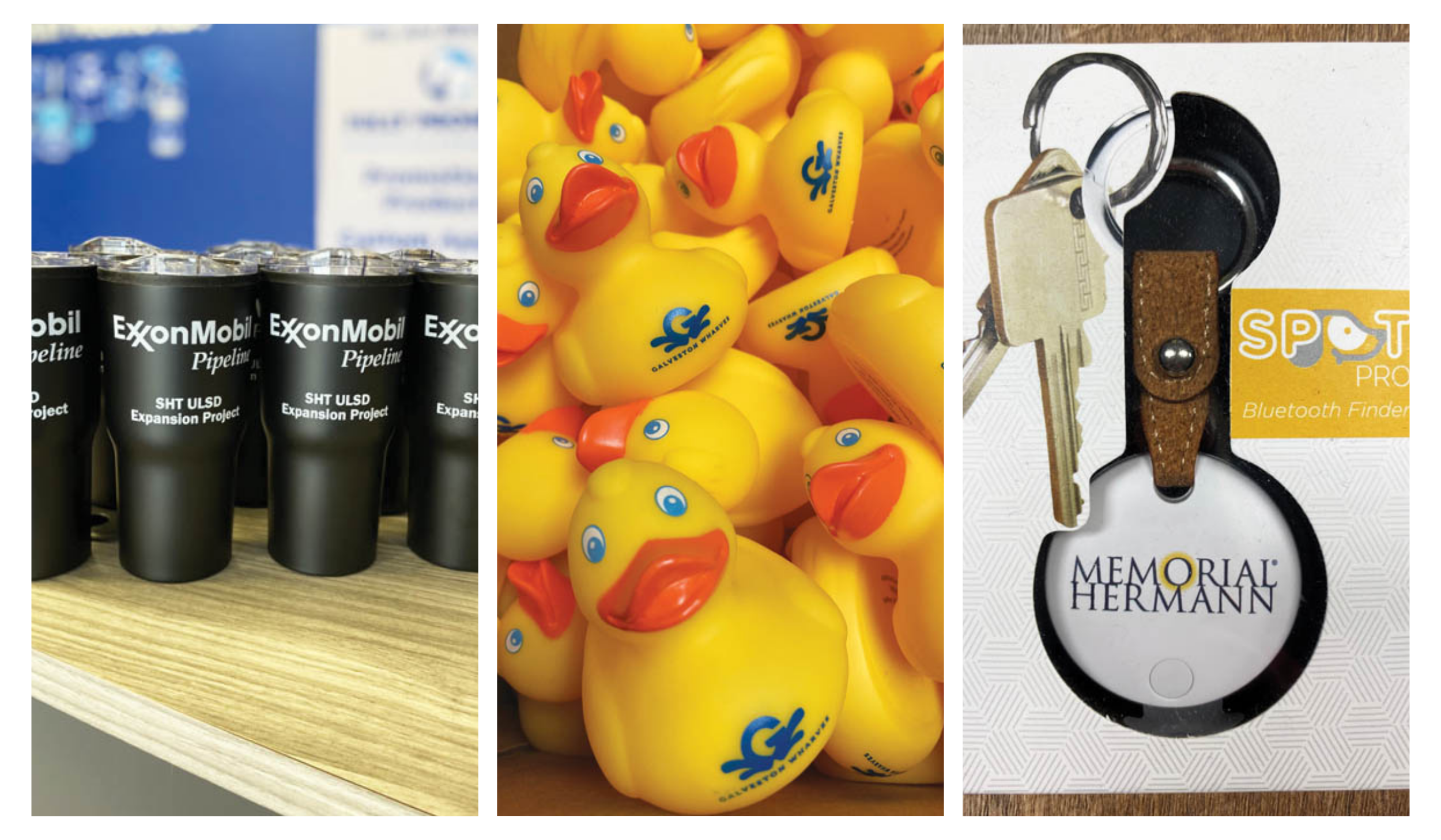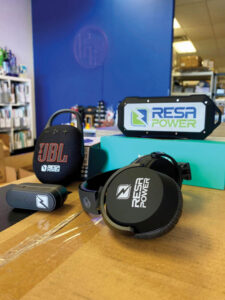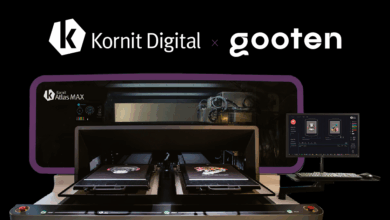It wasn’t long ago that corporate gifting was largely confined to the holiday season, and gourmet baskets or other generic tokens were among the common choices. Times have changed. Today, companies are not only recognizing the strategic value of gifting throughout the year but are also looking for brand-name goods to show how highly they value their clients. More than ever, promotional products are tangible representations of a brand’s identity, values, and commitment.
In the corporate world, branded gifts have become a vital tool for building relationships, fostering loyalty, and driving business growth, not only for clients but for employees as well. Thoughtful gifts can strengthen relationships with established and new clients, leading to increased loyalty and referrals, and can increase staff retention rates by rewarding valued team members.
 The corporate advantage: Streamlined branding & strategic vision
The corporate advantage: Streamlined branding & strategic vision
One of the key advantages of working with corporate clients is that they have established a well-defined set of brand standards. Corporations understand that the key to successful branding is consistency, and these brand standards not only save time and reduce errors but also ensure that every product aligns perfectly with the company’s overall brand identity.
Smaller clients may still be developing their brand standards, so colors, layouts, and other brand elements may change from project to project. As a result, they require a greater time investment to ensure brand alignment, which may result in a lack of brand consistency.
Corporate clients also approach promotional products from a strategic perspective. They see them as an integral part of their marketing, sales, and employee engagement programs. Products are chosen based on how they will connect with the client’s target audience, convey the desired message, and help them achieve their overall business goals.
Technological advances have expanded branding opportunities, particularly when it comes to decoration methods. In the past, embroidery and screen printing were the primary options, with limitations on color choices and minimum order quantities. But today, we have access to a wide range of cutting-edge techniques. Direct-to-film (DTF) printing, for instance, allows for unlimited colors and smaller quantities, making it ideal for complex designs and personalized items. UV stickers are another game changer, offering permanent, industrial-grade labeling for a variety of products.
These technological advancements have not only expanded our creative capabilities but have also enabled us to offer more flexible options with faster turnaround times and more cost-effective solutions for our clients.
Riding the wave of corporate gifting trends
 The corporate gifting landscape is constantly evolving, driven by changing consumer preferences and technological advancements. One of the most significant trends is the growing demand for brand-name products. Companies are no longer satisfied with generic items; they want recognizable, high-quality goods that reflect positively on their brand.
The corporate gifting landscape is constantly evolving, driven by changing consumer preferences and technological advancements. One of the most significant trends is the growing demand for brand-name products. Companies are no longer satisfied with generic items; they want recognizable, high-quality goods that reflect positively on their brand.
A few years ago, it would’ve been fine to give clients any wireless Bluetooth speaker with a cool, new feature. Now, clients are specifically asking for premium brands like JBL and Skullcandy.
This shift toward premium brands is fueled by the recognition that promotional products are a direct reflection of a company’s brand and values. While less expensive items may be suitable for mass giveaways at community events, gifts for top clients need to convey a sense of appreciation and quality.
Apparel has also undergone a significant transformation. The days of the ubiquitous polo shirt are long gone. Today, corporations are embracing a wider range of styles and fabrics that might be found in any upscale retail store. Brands like TravisMathew, Tommy Bahama, and even Brooks Brothers have become increasingly popular.
The result: Promotional products companies can offer their clients a more diverse and stylish corporate wardrobe. Instead of a team clad in identical blue polos, you might see women in cardigans or blouses and men sporting puffer vests — all while maintaining a cohesive and professional look that aligns with the company’s brand guidelines.
Thinking outside the goody bag
Corporations are going beyond trade shows and events with their branded products, finding new and innovative ways to leverage these items. They’re using them as leave-behinds during sales calls to create a memorable, lasting impression. Some are even building their own retail stores, offering branded apparel and merchandise for clients to purchase.
One of the most significant developments in recent years has been the rise of employee onboarding and appreciation programs. With hiring becoming increasingly competitive, companies are using welcome gifts to attract and retain top talent. These kits often include items like branded apparel, mugs, notebooks, and tech accessories, all designed to make new employees feel welcome and valued.
In a world where remote work is becoming increasingly prevalent, these onboarding kits provide a tangible way to connect with new hires and establish a strong company culture. It’s about creating a sense of belonging, even when employees are geographically dispersed.
It’s not just about onboarding either. Companies are investing in employee appreciation gifts to show their staff, at all levels, that they are valued. These gestures foster a positive work environment, boost morale, and improve employee retention.
Of course, as this trend becomes more popular, it’s increasingly likely that your competition is adopting it. How can you stand out?
Be a consultant, not just a vendor
In a competitive market, a smart strategy is to take a consultative approach rather than transactional.
When a corporation orders from a large online vendor, they’re essentially treated as a brand-new customer every time. There’s no personal connection, no understanding of their brand and corporate culture, and no guarantee of consistency.
With a consultative approach, you’re building long-term relationships with your clients — taking the time to understand their brand, their target audience, and their business goals. You become a trusted advisor, offering expert guidance and creative solutions that align with their unique needs. You’re at the top of their mind when they start a new project and need ideas. You’ll be ahead of the curve at the next trade show, already knowing your client’s preferences so you can find them the perfect products.
For example, one of my clients, a power company, likes fun items that light up. These items align with both their culture and their brand. Another client, a hospital, is keen on tech gadgets for their doctors. By anticipating their needs and curating a selection of relevant products, you can provide exceptional value and build lasting partnerships.
Any marketing person in a corporate office is incredibly busy. By building a strong relationship with them, you can serve as a valuable resource, offering ideas and solutions that help them achieve their goals. Plus, by being a trusted vendor to one department, you can have the opportunity to connect with other departments of the organization, such as human resources, safety, and community outreach.
Seizing opportunities & building relationships
Building relationships is paramount. Get to know your clients, understand their challenges, and become a valuable extension of their team. By providing exceptional service, creative solutions, and a deep understanding of their brand, you can forge lasting partnerships that drive mutual success.

 The corporate advantage: Streamlined branding & strategic vision
The corporate advantage: Streamlined branding & strategic vision


